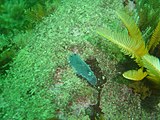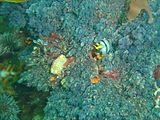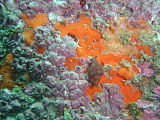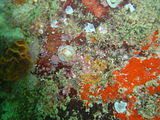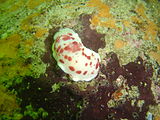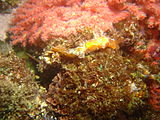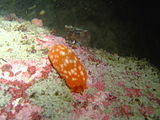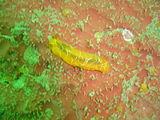Talk:Diving the Cape Peninsula and False Bay/Pinnacle
This page is for discussing the corresponding article or guide. For more about using talk pages check out Project:Using talk pages.
Comments
[edit]I'm not a great fan of long lists, escpecially not in star articles, not sure about myself, but how about ditching that long list and doing something like this instead? the current setup doesn't really have star quality to it I think.
Though the text blurbs should be made to a more similar size to make it look more uniform
- 6. Nudibranch tour: At least 20 species of Ophismobranch (sea slugs) have been seen at this site. It is not impossible to see as many as 12 species on a dive, though 6 to 8 is more likely.
- Black nudibranch
Tambja capensis is seen in depths usually deeper than 5m, otherwise unpredictable. The adults are usually solitary, but some years ago large numbers of juveniles were seen on blue-green bushy bryozoan colonies, where they were well camouflaged. - Blue speckled nudibranch
Dendrodoris caesia has been seen on the boulders in the bay at about 7m depth between Sponge Rock and the Pinnacle. - Brown dotted nudibranch
Cadlina sp2 are fairly frequently seen. Look for them on the fluffy lilac encrusting sponges which are common from about 6m down. - Cape dorid
Hypselodoris capensis can sometimes be found on the lilac sponge, but also on other substrates - Coral nudibranch
Phyllodesmium horridum is often seen on the red Multicolour sea fans in depths from about 4m to 8m, mostly in the 6m zone. - Crowned Nudibranch
Polycera capensis may be seen at various depths, on a variety of substrates. It is usually solitary and finding them is mostly a matter of luck and keeping a good look out. - Dwarf warty pleurobranch
Pleurobranchaea tarda has been seen on a cerianthid tube in the gravel zone. - Fiery nudibranch
Okenia amoenula is occasionally seen. At times it may be found on yellow scrolled false corals where it lays its eggs. There is a ridge to the south east of the pinnacle where there were large numbers at one time. Depth about 4 to 6m. - Gas Flame Nudibranch
Janolus nakaza is fairly common, but is usually found in deeper water, generally below 5m. - Ghost nudibranch
Lecithophorus capensis is often seen, frequently on bryozoans, but also on other surfaces. It may be at almost any depth. (not common in winter) - Heather's nudibranch
or Redspotted nudibranch Chromodoris heatherae is fairly common in the deeper areas to the north east of the pinnacle. It is quite easy to see as it is white with red spots. - Ink spot nudibranch
Ceratosoma ingozi is usually seen below 6m, and seems most common below 8m. It is usually quite common to the north east of the pinnacle. - The Iridescent nudibranch
Notobryon wardi is seen sporadically, mostly in fairly shallow water on red bait pods or encrusting algae of similar brown colour. (not seen in winter) - The Lemon pleurobranch
Berthellina citrina has been seen at night on the boulders just to the south of the pinnacle. - Protea nudibranch
Noumea protea are small and hard to spot, they may be seen on a pink encrusting sponge on the south west and north east face of the pinnacle at about 8m, and on the reefs off the large shore gully to the north. (All year) - Red sponge nudibranch or Orange dorid
Rostanga elandsia may occasionally be seen on orange encrusting sponge of exactly the same colour, making it very difficult to spot. At times it has been quite common. - Scribbled nudibranch
Doriopsilla miniata is occasionally seen. It favours the pale yellow turreted sponge, but is also seen in other places. - The Silver tipped nudibranch
Janolus capensis is usually common and can be found almost anywhere. - Soft coral nuibranch
Tritonia sp has been seen at Sponge Rock and in the gap south of the pinnacle. - Three-spot dorid
Aldisa trimaculata has been recorded at Pinnacle, but is hardly ever seen. - Whip fan nudibranch
Tritonia nilsodhneri has been seen on Flagellar and Sinuous sea fans in the gap south of the pinnacle and to the north east of the pinnacle. - White lined nudibranch
Flabellina capensis has been recorded, but is seldom seen at this site.
Hi Stefan, thanks for the feedback.
- My first response to this is that I initially had galleries, but was asked to remove them as a matter of policy. ie. WT does not have galleries. I have not seen this written in any guideline, so it may only be the opinion of one person, but it may also be that I have just not found it.
- There is also the problem of sacrificing information for style. Which is more important? to provide the useful information or to comply with the recommended style? By following your suggestions, I must leave out some of the descriptions as there is no photo. This is not a crisis, but does to some extent reduce the completeness of the information provided, reducing value to the traveller. Similarly, the if the long captions are shortened, there is an information loss, if the short ones are lengthened, they may require padding.
- If this style is to be applied to other sites it may have other problems, as yet unknown. This by itself would not bother me unduly, as trying it would be a way of finding out. (WT-en) Pbsouthwood 02:26, 15 October 2009 (EDT)
- Where was that gallery comment? They're a relative new Mediawiki feature, so they're not much used on WT, but AFAIK there's no policy against them (I use them on occasion, see eg. Okinawa#Eat) and illustrating wildlife is a perfect application for them. I also see absolutely no reason to start shortening or lengthening captions to make them line up.
- One suggestion though: instead of "hiding" the info at a single dive site, you might want to split it off into a dedicated article along the lines of African flora and fauna. (WT-en) Jpatokal 09:59, 15 October 2009 (EDT)
- Or expanding the ones with less, anyway nothing crucial but the Protea Nudibranch paragraph was so long it looked really silly, other than that it's fine just leave it as it is. That gallery comment was about a different use - a general gallery of pictures of the destination, is not the same as this - hmmm - "illustraion of concepts", I think most of us prefer to have general pictures of the destinations right aligned in the text. Another example of use of the gallery feature is Angkor
- And galleries don't have to be there in every guide, but should be seen more as a way to avoid long lists. As far as I can tell it's far from all the dive sites have this issue (though the other nomination does, in a different way)--(WT-en) Stefan (sertmann) Talk 10:16, 15 October 2009 (EDT)
Missing Nudibranches, one missing (Silver tipped nudibranch) does these all work for you? and do you have a photo of the missing one lying around? --(WT-en) Stefan (sertmann) Talk 17:00, 19 October 2009 (EDT)
- Blue speckled nudibranch (Dendrodoris caesia)
- Coral nudibranch (Phyllodesmium serratum)
- Dwarf warty (pleurobranch Pleurobranchaea tarda)
- Iridescent nudibranch (Notobryon wardi)
- Lemon pleurobranch (Berthellina citrina)
- Orange eyed nudibranch (Cratena capensis)
- Silver tipped nudibranch (Janolus capensis)???
- Soft coral nudibranch (Tritonia sp. 1)
- White edged nudibranch (Flabellina capensis)
Stefan, I see that you used a specific markup for the gallery. Where can I find the syntax/definition/instructions for this? Is it Wikimarkup or HTML or CSS or something else? (WT-en) Pbsouthwood 04:59, 23 October 2009 (EDT)
- I have put in most of the missing nudibranchs. The gallery is now more or less complete. Any further comments or suggestions? (WT-en) Peter (Southwood) Talk 08:21, 26 October 2009 (EDT)
Star nomination discussions
[edit]Discussions of the star nomination process for this article are archived at Project:Star_nominations/Archives#Diving_the_Cape_Peninsula_and_False_Bay.2FPinnacle

